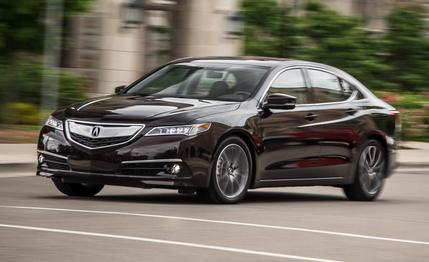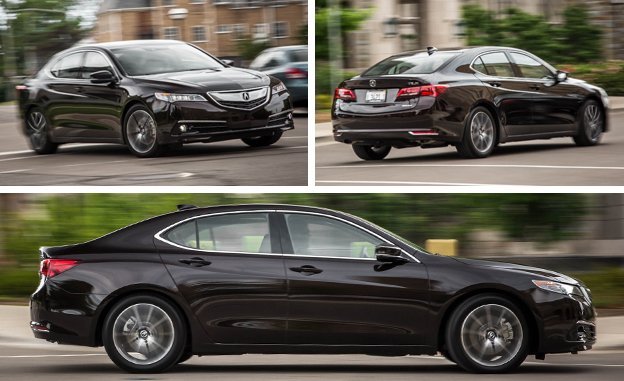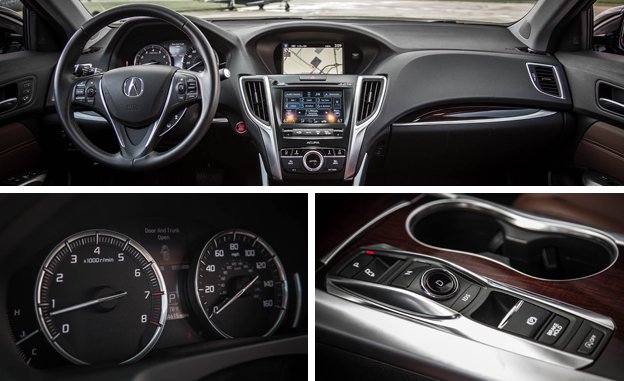 Instrumented Test
Instrumented Test
Motorsport is the ultimate proving ground—and marketing tool—for performance cars, including those from BMW, Cadillac, and Porsche, to name a few. Honda’s luxury brand also fits into that group as it tries to polish its image with specially built Acura TLX racing sedans that compete with Nissan GT-Rs, Cadillac ATS-Vs, and Ferrari 458 Italias in the Pirelli World Challenge. Unlike the other makes mentioned in this paragraph, however, the all-wheel-drive Acura TLX road car hasn’t received much feedback from pit lane.
The new-for-2015 TLX sedan replaced both the larger TL and the smaller TSX in Acura’s lineup. In place of the competition car’s 500-plus-hp twin-turbocharged V-6, the versions you can buy get either a 2.4-liter four-cylinder or a naturally aspirated 3.5-liter V-6 with 290 horsepower and 267 lb-ft of torque. An eight-speed dual-clutch automatic comes with the 206-hp four-banger, but the 3.5 is mated solely to Honda’s new nine-speed automatic. We’ve previously tested front-wheel-drive versions of both the 2.4-liter four and the 3.5-liter V-6—but the six-cylinder is also available with Acura’s torque-vectoring Super Handling All-Wheel Drive.

SH-AWD is one element of the TLX road car that is actually more advanced than the racer, as the system is able to individually over-rotate the rear wheels to aid in pivoting around corners. We’re not sure about the “Super Handling” moniker, but the system works especially well for powering out of tight bends where the front-drive cars’ inherent understeer is most apparent. Weight distribution actually improves a bit in the SH-AWD version, with the additional 146 pounds situated mostly at the rear. But more than 60 percent of our test car’s 3763 pounds still rested on the front axle.
The TLX, though, will never be a sports sedan until Acura makes it available with proper performance tires. Instead, very unsporty Goodyear LS2 all-season tires sit at each corner, sized 225/50R-18. While their tall sidewalls contribute to the TLX’s compliant ride, the tires simply lack the grip to exploit the SH-AWD’s potential. The stability-control system also cannot be fully disabled, limiting adhesion on the skidpad to a meager 0.82 g as the SH-AWD system teetered between pushing understeer and power-on oversteer. Braking from 70 mph was similarly so-so at 174 feet. The Acura’s new chassis feels solid and competent, and the electric power steering is nicely weighted if short on feedback. But the TLX struggles to keep up with its driver even in moderately aggressive cornering.
The direct-injected SOHC V-6 is relatively hushed yet pulls strongly up to its 6800-rpm redline with a familiar Honda growl. The SH-AWD’s added weight cancels out its traction advantage, making it about as quick to 60 mph as the front-driver. That benchmark takes 5.8 seconds and the quarter-mile is dispatched in 14.2 at 100 mph—comparable to a BMW 328i, Hyundai Genesis V-6, and Lexus ES350. But the TLX is about a second slower than the more-powerful BMW 335i and Infiniti Q50.
A button on the console allows the driver to choose among four driving modes (Econ, Normal, Sport, and Sport+), which adjust the assist from the electric power steering, as well as the throttle sensitivity, transmission shift points, and the all-wheel-drive programming. We noticed little difference among the settings in the real world, except that the transmission’s programming is hyperaggressive in Sport and Sport+ modes, holding lower gears for too long.

But there are simply too many cogs to manage, and Honda’s nine-speed is often caught out, hunting for the correct ratio. It also upshifts automatically at redline regardless of drive mode and is a bit slow to react to the shift paddles. And we’re still not sold on Acura’s push-button gear selector in place of an actual shift lever.
Both TLX V-6s carry an EPA-city rating of 21 mpg, with the SH-AWD rated at 31 mpg on the highway versus the front-driver’s 34. A similar 3-mpg gap separated our observed figures: 27 mpg for the two-wheel-drive car to the SH-AWD’s 24.
The TLX lacks the aggressively bolstered sport seats you’d expect in a performance sedan, but overall comfort is good and gadgets and amenities are plentiful. The instrument panel’s small, pixilated information screen already looks dated, however, and Acura’s two-tiered center displays are busy, redundant, and distracting in use.
The TLX SH-AWD carries a $2200 premium over the front-drive V-6 model, with sticker prices starting at $42,495. The list of standard features is long and includes seven airbags, a power sunroof, dual-zone automatic climate control, heated front seats, keyless entry and start, navigation, AcuraLink connectivity, a premium ELS audio system, blind-spot and forward-collision warnings, and lane-keeping assist. Our range-topping Advance model cost $3225 more and added adaptive cruise control, front-seat ventilation, remote start, and more.
Within its luxury strata, the top-end TLX is comparable with other mid-size, all-wheel-drive entries such as the Buick Regal GS and the Lincoln MKZ. However, the less prestigious—yet 10Best-worthy—Honda Accord V-6 is still more enjoyable to drive. And a few grand more than our example’s as-tested $45,720 will unlock an Audi S4, a true, all-weather sports sedan. While the TLX SH-AWD’s racing connection may appear legitimate on the starting grid, we’re still waiting for the transfer of performance to the real world.